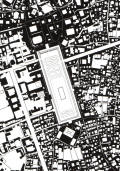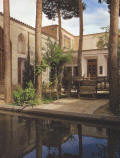
Heaven and Earth
Festschrift to Honor Karsten Harries
August 2007
 |
Heaven and Earth |
|
|
Vol. 12,
No. 1
August 2007 |
| ___M. Reza Shirazi Cottbus |
Of Space and Language |
|
Undoubtedly,
architectural thoughts of Martin Heidegger have played a serious and
considerable role in architectural discourse during the last decades. In
fact, his influence on architects and architectural theory is not limited to
phenomenology, but other attitudes such as post-structuralism,
deconstruction, as well as folding and virtual architecture. It could be
said that no other philosopher has had such a broad influence on the various
disciplines of architectural discourse. The discussion on the architectural features of the Heideggerian thought is mostly based on “Building Dwelling Thinking” (1951) and concentrates on his refers to the Greek temple in “The Origin of the Work of Art” (1936) and also his interpretations of the concepts such as “thing”, “gathering”, and “poetical” in his texts entitled “The Thing” (1950), “Language” (1950) and “…Poetically Man Dwells…” (1951). Here, I will try to focus on his later text “Art and Space” (1969) and will show how he elaborates his unique notion on space and place referring to his previous thoughts and discussions. I should emphasize that my reading of this text is an architectural reading which aims to catch architectural aspects of the text, carry them into the realm of architectural discourse and listen to their voice. This essay commences with various questions; questions that are being proposed intently to lead us to a fundamental question. Firstly, Heidegger focuses on sculpture. Sculptures are sculptured structures made of different materials and variously formed. Its forming, in fact, is the result of a demarcation that produces an enclosure and an excluding border. Space, in this way, becomes occupied by this sculptured structure and receives its unique character as a closed and empty volume. Nevertheless, according to Heidegger, this view is a common and ordinary view which is insufficient and makes us confused. Various questions are proposed: Does sculptured body embody space? Is sculpture an occupation of space? In this way, is sculpture interrelated with technical-scientific conquest of space received us from Galileo and Newton? Is space in all directions homogenous? According to Heidegger, although space has been discussed from different perspectives, its very character has not been yet explained and the space character of space is yet unclear. Thus, the fundamental question is asked: what space as space would be and how Being is attributed to it? Heidegger states that “the urgency of such questions demands from us a confession: So long as we do not experience the special character of space, talk about artistic space also remains obscure.”[1] If we assume art as the bringing-into-the-work of truth, and truth as unconcealment of Being, then is the graphic art the realm of the authentic space? In other words, is not the space as space present in the domain of graphic art? Heidegger has argued about the notion of setting-into-the-work of truth in “the Origin of the Work of Art”. In this text, discussing how the happening of truth is occurred in a work of art, he refers to a Greek Temple. A Greek Temple portrays nothing, but is the realm of the presence of god. The temple, “standing there” produces a place. “Standing there” denotes that the temple building does not stand everywhere, but “there”, in a special place, a precise location which belongs to it. This location is constructed through gathering and uniting paths and relations of the surrounding and is based on the resting of the building on the rocky ground. Thus, earth is present in it and the building opens up a world by its rising: “Towering up within itself, the work opens a world and keeps it abidingly in force.”[2] Thus, the temple work, as a work of art, gathers all the things and the environment together by opening up a world and by means of it founds a space. A work, setting up a world and setting forth the earth “is the instigation of the strife in which the unconcealment of beings as a whole, or truth, is won.”[3] Heidegger catching the essence of truth listens to the Greek word, “aletheia”, which used to mean unconcealment. Truth is given, if the Being comes out from its concealment and remains unconcealed. But the world could not be opened and truth could not occur unless a thing places this opening within itself and accepts it. Truth is as long as an opening up that establishes itself within something and settles itself in it. Here, the importance of a work as a gathering thing appears; a work which becomes the realm of the presence of the Being. And hence, graphic work, sculptured body, and here the architectural work becomes capable of realizing and concretizing of the authentic space, because the work of architecture is capable of presenting truth as the unconcealment of Being. Architectural work, a Greek temple, provides the realm of the presence of Being in its unconcealment through setting up a world and setting forth the earth. Thus, art work, and here the Greek temple, is setting-into-the-work of truth. From another viewpoint, if the work is the sphere of the happening of truth, then, an artist is not a founder and an agent of the work, but a person who just provides the possibility of such an event and is an assistant of such a creation. An artist, through his creation, rests and dwells in the realm of the presence of Being. He lets the Being to be set into the work. However, what is the special character of space? How and where can we catch it? Heidegger once more refers to the language, because he believes that “language is the highest and everywhere the first. Language beckons us, at first and then again at the end, toward a thing’s nature.”[4] Therefore, the essence of space speaks in language and we should listen to it. In language ‘clearing-away’ (Räumen) is uttered. It means to clear out (roden), and also to free from wilderness. Clearing-away, in fact, is providing a place. Räumen, (clearing-away) produces a realm and openness for man’s dwelling. Through clearing-away the dwelling man preserves his home and frees from homelessness. “Clearing-away is release of the place at which a god appears, the places from which the gods have disappeared, the places at which the appearance of the godly tarries long. In each case, clearing-away brings forth locality preparing for dwelling. Secular spaces are always the privation of often very remote sacred spaces.”[5] Thus, space as clearing-away releases the places. What does mean ‘releasing’? Releasing is to release a domain from wilderness, providing it for a great event, for dwelling of men. Clearing-away provides a place to be dwelling-place. Clearing-away is the releasing of the realms in order to giving rise to dwelling. It provides a presence sphere for the gods and men. Accordingly, dwelling, and building, – we have learnt in ‘Building Dwelling Thinking’ that building and dwelling belong together in their essence – is the setting of the realm of presence. If it is so, could it be occurred without architecture? Clearing-away in this sense becomes the nature of architecture. Architecture is clearing-away of places, to become the realm of the presence and the dwelling of man and god. If we recollect the Greek temple, in that work space is present as clearing-away, for it clears-away through its ‘standing there’ and gathering its surroundings, and allows the dwelling of man and presence of god through releasing the place from wilderness and barrenness. The other feature of the clearing-away which is hidden in the Räumen deserves more consideration, i.e. releasing from wilderness. Wilderness and barrenness does not imply a place, so that it is not capable of keeping any space. Barrenness lacks any coordinates, and is refer-less and relate-less extension. In barrenness, nothing rests, because it is not capable of gathering the relations and paths of the environment and appearing as a thing. Barrenness is an extension-less extension and a dimensionless sphere. In barrenness the connection of earth and heaven does not occur, and thus dimension does not appear, as we have learnt from “…Poetically Man Dwells…”. But, clearing-away clears the wilderness and establishes the place. It gathers the environmental relations and paths, coordinates the surrounding, and work as a work gets its ability to be present. |
||
 Image 1: Nagshi-Jahan Square, Isfahan, Iran  Image 2: Typical Iranian house with courtyard  Image 3: Nagshi-Jahan Square, Isfahan, view from Imam Mosque |
However,
according to Heidegger, clearing-away happens in making-room (Einräumen),
which is as such both granting and arranging. When we make-room for
something, we give it a place, through which we arrange and organize
that region in a special way. Thus, there is an openness in which things
come to presence and allow dwelling. In making-room of the Greek temple,
a region comes to forth that within it all the things belong to their
relations, gather with each other, and make the presence of gods and
dwelling of men possible. “Place always opens a region in which it
gathers the things in their belonging together.”[6]
[1] Heidegger, M. Art and Space, in Rethinking architecture: a reader in cultural theory, N. Leach, Editor. 1997, Rotledge: London. p. 122. [2] Heidegger, M. The Origin of the Work of Art, in Martin Heidegger,Basic Writings, D.F. Krell, Editor. 1996, Routledge: London. p. 169. [3] Ibid, p.180. [4] Heidegger, M. Poetically Man Dwells, in Poetry, Language, Thought, A. Hofstadter, Editor. 1971, Harper and Row: New York. p. 216. [5] Heidegger, M. Art and Space, op cit, p. 122. [6] Ibid, p.123. [7] Heidegger, M. Building Dwelling Thinking in Martin Heidegger, Basic Writings, D.F. Krell, Editor. 1996, Routledge: London. p. 355. [8] Heidegger, M. Art and Space, op cit, p. 123. [9] Heidegger, M. The Thing, in Poetry, Language, Thought, A. Hofstadter, Editor. 1971, Harper and Row: New York. p. 169. [10] Heidegger, M. Art and Space, op cit, p. 124. |
|
|
|
||
| feedback | ||